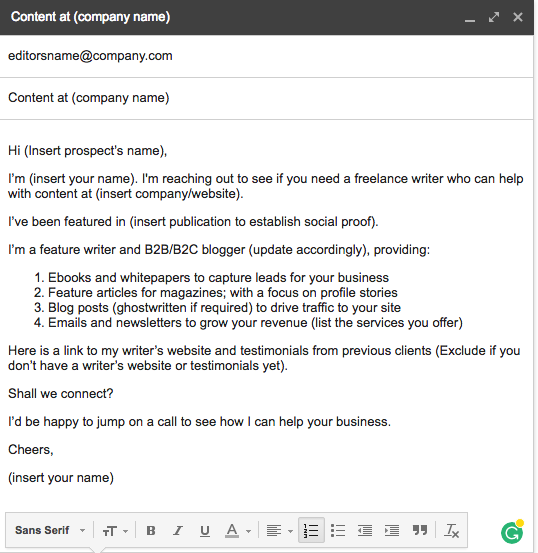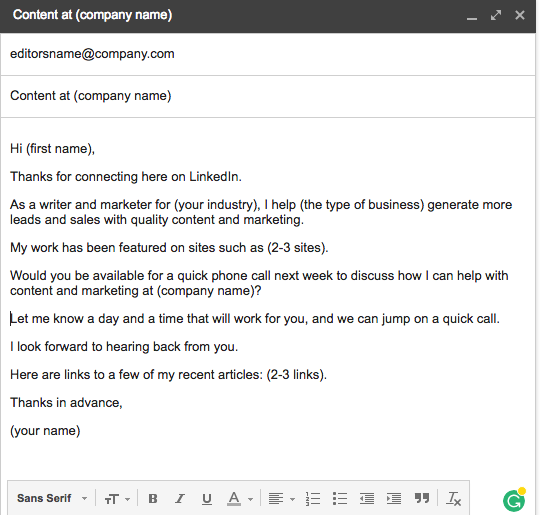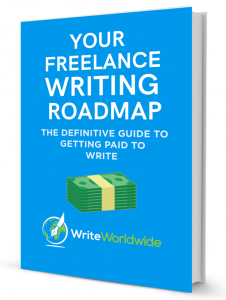You know you write well, but you can’t land high-paying freelance writing gigs, no matter what you do. You’re stuck writing for content mills. Earning a few dollars here and there. Dreaming of those lucrative clients that other freelance writers attract effortlessly.
The reality is this: To become a successful freelance writer you need to be more than just a good writer. You need to develop a business mindset. You need to market yourself. You need to put in the effort to find clients.
While there are many ways to find well-paying freelance writing gigs, cold-pitching remains one of the best. Is this the only strategy? No. But it’s a strategy that works.
It’s how I’ve built a $2000/month writing business in less than a year. Richard Rowlands, Ciaran Gilligan and many other writers – who I now call friends – have done the same. It’s a strategy that Bamidele Onibalusi used when he created the Earn Your First $1000 as a Freelance Writer challenge. It’s also a strategy that Jorden Roper used to build a $5000/month freelance writing business in four months.
I could go on. But the bottom line is this: Cold pitching has worked for many – and chances are – it’ll work for you.
So, today, I’m sharing three pitching templates you can use when pitching for writing work. The team at WriteWorldwide use these templates to land lucrative writing jobs. Only recently I wrote about how I landed one of my highest paying freelance writing clients ($250 for a blog post) by using one of these templates.
I’ve dissected each template and highlighted the ideal circumstances to use them. You can skip ahead and start pitching. But if you’re new to cold-pitching, I urge you to read the following guidelines:
1. Cold pitching is a numbers game
You may send hundreds of emails before getting a response. Don’t despair, if you keep at it, and follow-up with every prospect using the 3-7-7 formula, you will see results. It’s only a matter of time.
To put it in perspective, when I started pitching for work, I sent 80 pitches and landed only two clients? Was it worth it? Yes. Both clients are still clients today, one of which is my most lucrative.
2. Your emails must be well written
If your emails have many grammatical errors, don’t expect responses. If you’re unsure, send your pitches to a friend who’s well versed in the language and who can help you.
Also feel free to send your pitches to the team at WriteWorldwide. We’d be happy to give you a few pointers. Finally, you may need to take the time to improve your English writing skills. If that’s the case, I’d suggest reading our guide: The Ultimate Guide on How to Improve Your English Writing Skills.
3. Pay attention to your subject line
You don’t want your email to end up in the spam folder. Variations of “Content at (name of business)” usually work well. That’s the standard subject line I use for all my pitches.
Okay, now on to what you came for: the pitches to help you land those high-paying writing gigs.
Pitching Template 1: The “We Have Something in Common” Pitch

Ideal circumstances:
This pitch is useful for contacting a prospect if you share mutual communities or groups online. You can specify LinkedIn, Twitter or Facebook. It’s up to you. Adding testimonials boosts your social proof and draws your prospect’s attention to the value you can offer them, increasing your chances of getting hired.
Pitching Template 2: The “Blind” Pitch

Ideal circumstances:
This pitch is ideal for making contact with publications and websites that have never used your services before. It establishes what the email is about, leads with social proof and provides a breakdown of your services.
Listing other services you offer is another opportunity to stay top-of-mind with the prospect. Even if they don’t need you right now, you want to be on their go-to list for future projects. The question at the end encourages them to reply. I used this template to land that $250 blog post I was talking about earlier.
Pitching Template 3: The Linkedin “How Can I Help Your Business” Pitch

Ideal circumstances:
You need to first make a connection with a prospect on Linkedin before using this template. Once established, this simple pitch is a powerful way to encourage communication.
By beginning with “thanks”, focusing on why your service is relevant to their industry and including samples of your work, you increase the chances of getting a response. Making the prospect the centre of your pitch – how you can help them, and what works best for them – is key.
Our very own Richard Rowlands shares a deep-dive breakdown of this winning LinkedIn pitch he’s used many times to land freelance writing gigs. If you want to take things further read his post: How to Find Freelance Writing Clients on Linkedin (A System That Works).
Conclusion
Writing well does not guarantee that you’ll make money from freelance writing. It’s only one piece of the puzzle. You need to put in the hard work to find those elusive freelance writing clients, and cold pitching is one strategy that will help you.
In this post, I’ve shared 3 pitching templates you can use to help land high-paying freelance writing gigs. For more pitching templates download our Pitching Template Cheat Sheet below.




Eye opening. Thank you.
Hi Sammy,
Glad you found it valuable 🙂
Cheers,
I am still new and I have only subscribed to Freelance writing. I am a Freelance Journalist and want to write paying stories. i have tried to pitch, but it seems i do not know how to do it convincingly and so I have never gotten any response even one which says, ‘we have received your interest’.
Can you help me out please. How I wish I could have a chance to look at your pitches that have really earned you well.
The other concern is that at the moment I do not have a website for my stories, but I have done stories for Media outlets.
Thanks.
Hi Mwiri,
Thank you for your comments. There are several articles on the blog that show how these pitches have helped us earn serious money:
How to Land Freelance Writing Jobs Online, Fast – shows you how I landed a $250 blog gig and shares the pitch
How I Landed a $6250 Freelance Writing Gig (As a Beginner) – shows you how I landed a lucrative writing gig with no experience and shares the pitch.
Also if you want access to all the pitches, and further examples, download our Pitching Template Cheat Sheet. The form to sign up and receive it is at the bottom of the post too.
Hope this helps.
Cheers,
Nick
Hi there! I realize this is somewhat off-topic but I had to ask. Does building a well-established website like yours take a lot of work? I’m completely new to operating a blog however I do write in my journal daily. I’d like to start a blog so I can share my personal experience and views online. Please let me know if you have any kind of suggestions or tips for new aspiring blog owners. Thankyou!
Hi Maura,
Everything worth having takes work. With the many free themes and website builders online, it’s not hard to start a blog. Those that succeed are those that remain patient and don’t give up when they don’t see instant results. The reality is that with the many blogs that are launched daily and the billions of sites out there, you just have to keep at it.
Cheers,
I’m curious about your experience with #3, if you personally use that approach. I don’t do cold pitches, but on the receiving end, I immediately disconnect from anyone I connect with through LinkedIn or other social media who responds by trying to sell me something. I have no idea whether I’m typical in that, so I’d be interested to hear about the response.